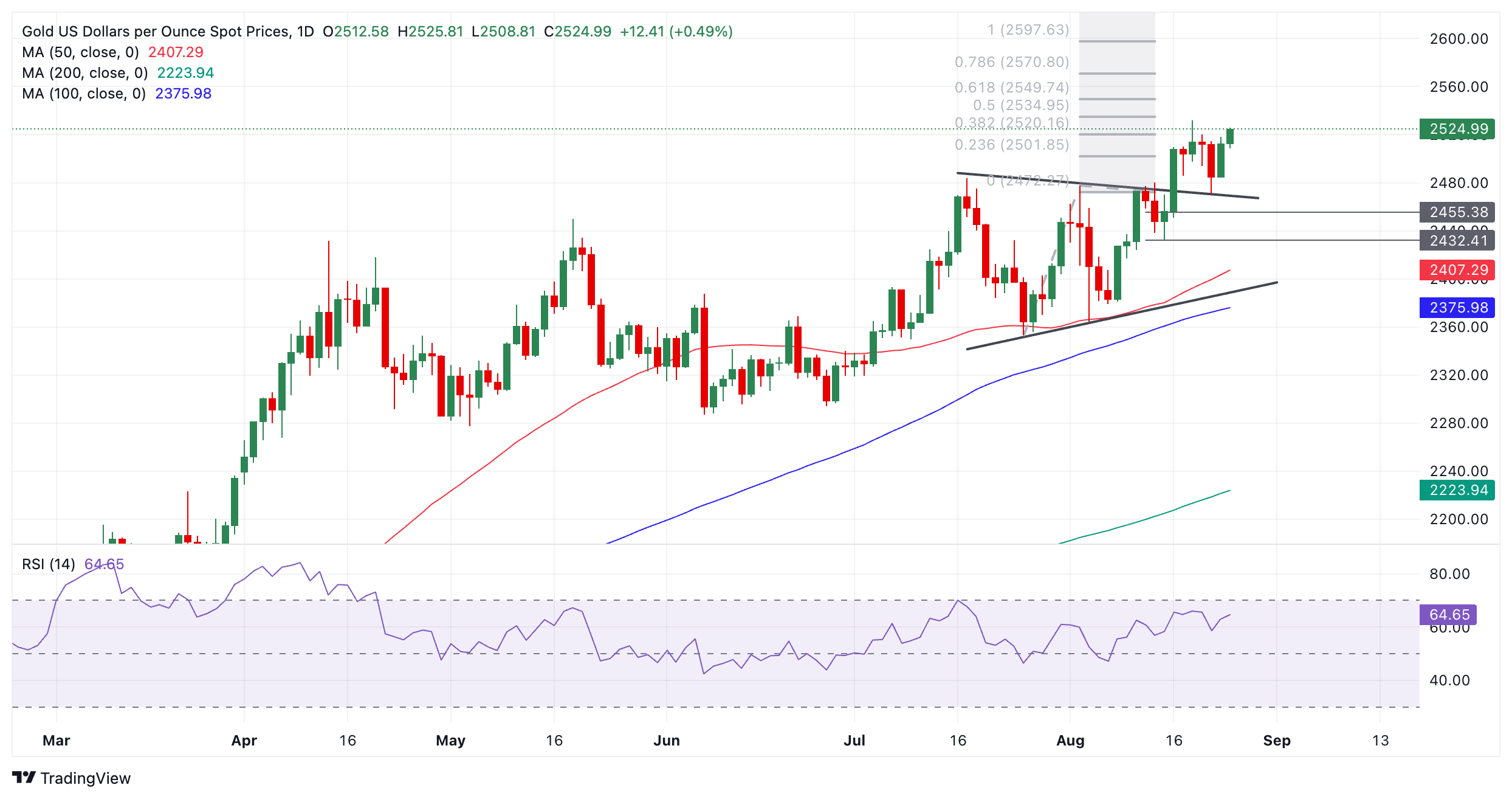- Gold extends its rally from Fed Chair Powell’s speech on Friday as Middle East tensions ratcheted up over the weekend.
- The precious metal was already rallying after the Fed chair’s speech signaled the beginning of a lower interest-rate regime.
- Technically, XAU/USD resumes its overall uptrending bias and edges towards its next target at $2,550.
Gold (XAU/USD) trades up into the $2,520s on Monday, just off its all-time highs of $2,531, as a combination of safe-haven demand sparked by rising geopolitical tensions in the Middle East, and increased confidence US interest rates will track lower in the medium-to-long term, make the non-interest paying asset more attractive to investors.
US Durable Goods orders, released during the US session, showed a 9.9% surge in Durable Goods orders in July, which was a big turnaround from the 6.9% decline in the previous month, and well above consensus estimates of a 4.0% increase. It was the largest gain since May 2020 and suggested a resilience in the US economy that goes against the countervailing mood of pessimism.
That said, Gold quickly recoverd after momentarily slipping following the release, to continue trading in the $2,520s, within its daily range.
Gold edges higher as risk aversion helps safe-haven demand
Gold trades higher on Monday as geopolitical risk aversion increases investor demand for safe-havens, of which Gold is a notable example.
Rising tensions in the Middle East are a factor, after the Israelis launched a mass pre-emptive strike on Hezbollah positions in Lebanon over the weekend. Hezbollah then retaliated with a hail of missiles and drone strikes in northern Israel. Fears Iran could enter the conflict after weeks of threats also persist.
Powell speech drives Gold higher after sea change in language
Gold rose over a percentage point on Friday after the Chairman of the Federal Reserve (Fed) Jerome Powell made a speech at the Jackson Hole central banking symposium, in which he gave the clearest signals yet that the Fed is going to cut interest rates.
Powell raised concerns that the US labor market is slowing down due to the impact of continuously high interest rates, which have remained at a peak range of 5.25%-5.50% since July 2023. Whilst these had successfully reduced inflation, they were now having a negative impact on company hiring.
“Upside risks to inflation have diminished, downside risks to employment have increased,” said Powell, adding that “Labor market cooling is unmistakable, no longer overheated."
US government bond yields, which reflect investors' outlook for inflation and interest rates, fell after his speech. The yellow metal tends to appreciate when yields drop as it reduces the opportunity cost of holding non-interest paying Gold.
The US Dollar Index (DXY), which measures the strength of the Dollar against a trade-weighted basket, – and is negatively correlated to Gold – sank to a new year-to-date low of 100.53 on Monday morning as traders continued to digest Powell’s comments.
Gold has benefited from elevated expectations that the Fed will make a “mega” 0.50% interest-rate cut in September – double the usual 0.25% reduction. From a probability in the mid-20% prior to his speech, the chances of such a bumper cut have risen back up to the mid-30% afterward, according to the CME FedWatch tool, which uses the price of 30-day fed fund futures in its calculations.
Technical Analysis: Gold extends bounce from top of old range
Gold (XAU/USD) extends the rebound from support at the top of its old range. Despite trading sideways recently, the pair remains in an uptrend and given “the trend is your friend” this continues to favor longs over shorts.
XAU/USD Daily Chart

The breakout of the range on August 14 generated an upside target at roughly $2,550, calculated by taking the 0.618 Fibonacci ratio of the range’s height and extrapolating it higher. This target is the minimum expectation for a follow-through after a breakout based on principles of technical analysis.
A break above the $2,531 all-time high from August 20 would provide added confirmation of a continuation higher towards the $2,550 target.
Alternatively, a break back inside the range would negate the upside projected target. Such a move would be confirmed on a close below $2,470 (August 22 low). It would change the picture for Gold and bring the short-term uptrend into doubt.
Gold is in a broad uptrend on medium and long-term time frames, however, which further supports an overall bullish outlook for the precious metal.
Risk sentiment FAQs
In the world of financial jargon the two widely used terms “risk-on” and “risk off'' refer to the level of risk that investors are willing to stomach during the period referenced. In a “risk-on” market, investors are optimistic about the future and more willing to buy risky assets. In a “risk-off” market investors start to ‘play it safe’ because they are worried about the future, and therefore buy less risky assets that are more certain of bringing a return, even if it is relatively modest.
Typically, during periods of “risk-on”, stock markets will rise, most commodities – except Gold – will also gain in value, since they benefit from a positive growth outlook. The currencies of nations that are heavy commodity exporters strengthen because of increased demand, and Cryptocurrencies rise. In a “risk-off” market, Bonds go up – especially major government Bonds – Gold shines, and safe-haven currencies such as the Japanese Yen, Swiss Franc and US Dollar all benefit.
The Australian Dollar (AUD), the Canadian Dollar (CAD), the New Zealand Dollar (NZD) and minor FX like the Ruble (RUB) and the South African Rand (ZAR), all tend to rise in markets that are “risk-on”. This is because the economies of these currencies are heavily reliant on commodity exports for growth, and commodities tend to rise in price during risk-on periods. This is because investors foresee greater demand for raw materials in the future due to heightened economic activity.
The major currencies that tend to rise during periods of “risk-off” are the US Dollar (USD), the Japanese Yen (JPY) and the Swiss Franc (CHF). The US Dollar, because it is the world’s reserve currency, and because in times of crisis investors buy US government debt, which is seen as safe because the largest economy in the world is unlikely to default. The Yen, from increased demand for Japanese government bonds, because a high proportion are held by domestic investors who are unlikely to dump them – even in a crisis. The Swiss Franc, because strict Swiss banking laws offer investors enhanced capital protection.
Information on these pages contains forward-looking statements that involve risks and uncertainties. Markets and instruments profiled on this page are for informational purposes only and should not in any way come across as a recommendation to buy or sell in these assets. You should do your own thorough research before making any investment decisions. FXStreet does not in any way guarantee that this information is free from mistakes, errors, or material misstatements. It also does not guarantee that this information is of a timely nature. Investing in Open Markets involves a great deal of risk, including the loss of all or a portion of your investment, as well as emotional distress. All risks, losses and costs associated with investing, including total loss of principal, are your responsibility. The views and opinions expressed in this article are those of the authors and do not necessarily reflect the official policy or position of FXStreet nor its advertisers. The author will not be held responsible for information that is found at the end of links posted on this page.
If not otherwise explicitly mentioned in the body of the article, at the time of writing, the author has no position in any stock mentioned in this article and no business relationship with any company mentioned. The author has not received compensation for writing this article, other than from FXStreet.
FXStreet and the author do not provide personalized recommendations. The author makes no representations as to the accuracy, completeness, or suitability of this information. FXStreet and the author will not be liable for any errors, omissions or any losses, injuries or damages arising from this information and its display or use. Errors and omissions excepted.
The author and FXStreet are not registered investment advisors and nothing in this article is intended to be investment advice.
Recommended content
Editors’ Picks

AUD/USD: Further recovery targets 0.6400
AUD/USD soared to three-day highs around 0.6180 on Wednesday, bouncing back from multi-year lows near 0.5900 as easing worries over US tariffs helped fuel the recovery.

EUR/USD: Next on the upside comes the YTD peaks
EUR/USD ended the day with modest loses, coming under renewed downside pressure after hitting tops near 1.1100 the figure on the back of the late bounce in the Greenback.

Gold remains bid, refocuses on $3,100
Prices of Gold now regain some balance and approach the $3,100 zone per troy ounce on Wednesday after President Trump announced a 90-day pause on reciprocal and 10% tariffs. FOMC Minutes pointed to further caution from officials.

Bitcoin, crypto prices pump as Trump pauses tariffs for 90 days
Bitcoin (BTC) and several top cryptocurrencies rallied on Wednesday after President Donald Trump announced the United States (US) would pause its reciprocal tariff on 75 countries following their failure to retaliate and the opening of negotiations with key government agencies.

Tariff rollercoaster continues as China slapped with 104% levies
The reaction in currencies has not been as predictable. The clear winners so far remain the safe-haven Japanese yen and Swiss franc, no surprises there, while the euro has also emerged as a quasi-safe-haven given its high liquid status.

The Best brokers to trade EUR/USD
SPONSORED Discover the top brokers for trading EUR/USD in 2025. Our list features brokers with competitive spreads, fast execution, and powerful platforms. Whether you're a beginner or an expert, find the right partner to navigate the dynamic Forex market.



